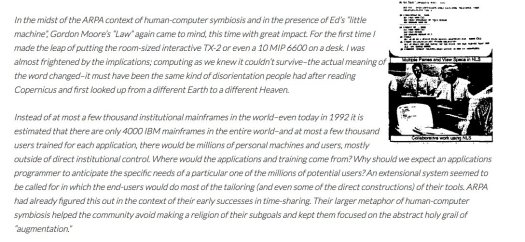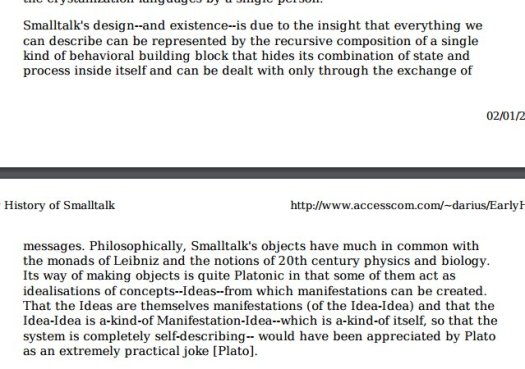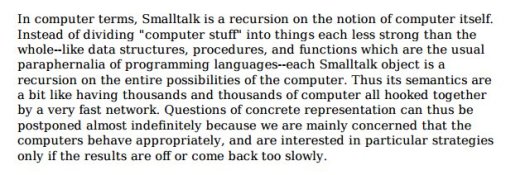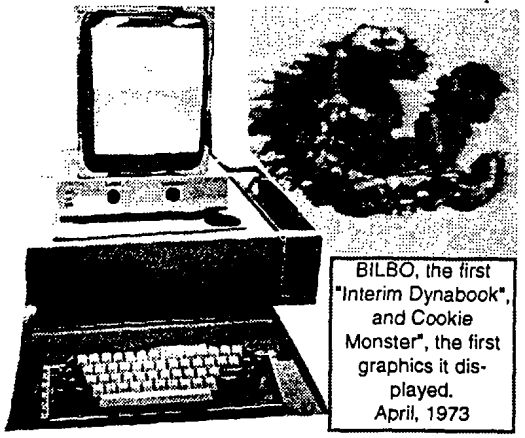Sesame Street was created by veteran officers of the US Army’s Psychological Warfare Office with the goal of blunting the
force of social-justice radicalism in the United States by promoting the liberal ideology that oppression not a structural economic injustice, but a matter of poor individual character or bad social skills. In a 1970’s state-directed project to determine how humans establish cathexis with military hardware, computer engineer Alan Kay leveraged the graphical capabilities of highly-advanced prototype personal computers to display animations of one of Sesame Street’s most popular characters, Cookie Monster, because he felt this would help children see personal computers not as technological artifacts derived from Air Force weapons, but as friendly and even “magical” helpers in their lives.
Kay, who developed the PARC Alto computer and Smalltalk programming language concurrently with Xerox funding the creation of Sesame Street,
is very clear about this in his “
Early History of Smalltalk.” Building the Sesame Street characters in to the design of the Alto’s user
interface was an evolutionary step in ARPA’s 20 year study on “
Human-Computer Symbiosis.”
Aerial combat was the initial use case for this cyborg symbiosis, and in the 1950’s/early 1960s this research was directed towards neuromuscular interfaces with the hardware – humans being literally “wired in”
to the computers. By the late 1960s / early 1970s, computer displays + pointing devices (derived from Air Force radar scopes) had become
responsive enough that it was possible to use the computer as an interface to display traditional works of art: books, music, animation.
This is where it became possible for the user to establish deeper cathexis with the hardware across the full range of human emotions. Control feedback loops became visual / endocrine, not
mechanical / muscular. This was the conceptual leap that Engelbart + Kay pulled off at SRI and PARC.
It took Steve Jobs another few years to figure out how to commodify that cathexis, and then the Personal Computer Revolution was underway.


Kay was trying to create a paradigm shift in ARPA’s ideas about human-computer symbiosis.
This is Kay first realizing the implications of Engelbart’s vision and how portable computing will completely change the world:


The point to all of this is that it’s been a military project w/ military goals all along. Computing never escaped the defense labs and
became some pure technology of liberation. That’s a libertarian myth about a cultural shift that happened in the industry the late 1960s.
Computer networks evolved from centralized air defense systems designed to fight a nuclear war to decentralized counterinsurgency systems.
The state’s application of force evolved from direct application of kinetic force (“monopoly on violence”) to surveillance and coercion.
This understanding informs Alfred McCoys research on the origins of the
surveillance state in the US colonization of the Philippines.

The camouflage that the state uses to hide its coercion creates all kinds of mutant aesthetic offspring.
Some of them look “kooky” on the surface because they appear in places where you don’t think you should find them, at least at first; the whole point of camouflage is to allow infiltration into spaces where you don’t belong.
Computing devices / software still mostly “work” for people because of how they establish + amplify cathexis – with the devices themselves,
or with images + texts, that might represent real people or fictional people or video game characters or whatever.
It’s important not to mystify this or think there’s some essential spirit / zeitgeist in the network. If “the internet” (social software)
feels oppressive or fashy that’s because of how the software interfaces and moderation systems were designed (this is again based half really banal needs-of-the-marketplace stuff, and half on really deep and particular assumptions about human selfhood and what it means to be a human interacting among other humans), and how the behavioral
standards of online communities have been cultivated. You can still find pockets of liberated space online, although IMO they were more common 20 yrs ago.
Kay saw computers as the recursive application of processes that hide their internal state and behaviors.


These are the “objects” of Object-Oriented programming.
Smalltalk is a recursion on the computer itself – a nested hierarchy of objects that each simulate little computers. Kay’s inspiration for
this came from his study of cellular biology – cells hide the entropy of their metabolic processes from each other and “communicate” by passing proteins
(hormones) thru a membrane. Equilibrium is maintained in an organism by complex, interdependent systems of feedback between cells even though the cells themselves remain physically distinct from each other. Kay designed operating systems where logically distinct “objects” communicated thru passing “messages” and
elicited a hormonal response (cathexis / user-friendliness) in users thru the display and manipulation of culturally meaningful symbols.
I got started on studying this history of the tech industry last year after recursively applying Pynchon to Pynchon, supposing that Thomas Pynchon’s own career mirrored the stories of many of his protagonists: ordinary people who slowly become aware of massive imperial conspiracies surrounding them. In a similar vein you can get insights on the technology industry by recursively applying Kay’s idea of a computer the historical context in which he designed computers: Palo Alto in the 1960s and 1970s.
All of these defense tech projects in the “ARPA Community” were classified or highly bureaucratically segmented systems which hid their behaviors and internal state from the outside and
communicated in various “messages” – money, research, classified data, products. Kay’s invention of the personal computer was an iteration
of larger political / industrial / economic forces – but Kay’s particular conceptual model of the computer (encapsulated or compartmentalized systems of logic with their own internally-consistent but globally incompatible states of truth) can provide a map to the specific context (ARPA / California / War on Vietnam / MKULTRA) that he was working in.
Think of the cults and psychotherapy practices that were popular in the Bay Area of the 1960s (and incorporated into the work culture ARPA projects like Douglas Engelbart’s research at SRI) as “objects” in the computer-programming sense. Each one is compartmentalized, hides its behaviors and internal state from the outside (secret knowledge for the initiates / doctor-patient privilege), acts internally on propositions that may not hold true outside of the cult, and only interacts indirectly with the outside world through recruiters, evangelizers, fundraisers. Group therapy, death squads, police informants all act as these kinds of objects, nested concentrically within the law enforcement + intelligence agencies that operate them, separated by layers of procedural compartmentalization in the same way logical objects in Smalltalk’s object hierarchy are separated, or how biological cells in an organism are kept distinct but also bound into tissues and organs by cellular membranes.
Even though Kay hasn’t achieved the capitalist success of entrepreneurs like Bill Gates or Steve Jobs, in Smalltalk he created (or really “encapsulated”) a microcosm of how the decentralized capitalism of Silicon Valley functions.
Sesame Street, meanwhile, continues on its mission of pathologizing political radicalism and treating it as a developmental issue in children,
with a new program being launched in Syrian refugee camps to use newly-rebooted Arabic-language version of Sesame Street to turn children away from being recruited by ISIS.



































 Happy reading.
Happy reading.![The Year of Incline [2014] Codex 2014](/forums/smiles/campaign_tags/campaign_incline2014.png)



